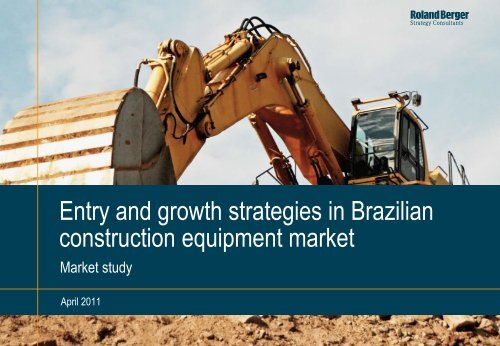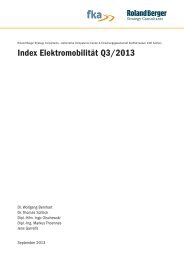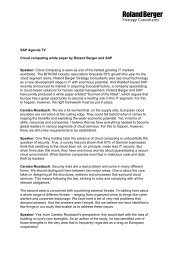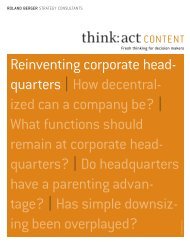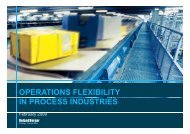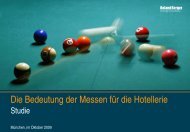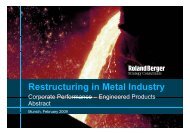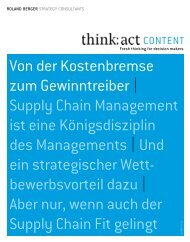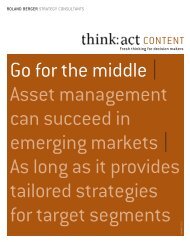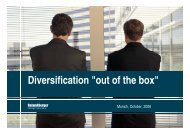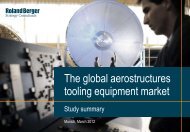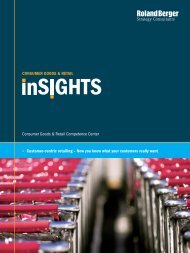Entry and growth strategies in Brazilian construction ... - Roland Berger
Entry and growth strategies in Brazilian construction ... - Roland Berger
Entry and growth strategies in Brazilian construction ... - Roland Berger
You also want an ePaper? Increase the reach of your titles
YUMPU automatically turns print PDFs into web optimized ePapers that Google loves.
2011-04-14_Market_<strong>Entry</strong>_Strategy Brazil.pptx<br />
1<br />
<strong>Entry</strong> <strong>and</strong> <strong>growth</strong> <strong>strategies</strong> <strong>in</strong> <strong>Brazilian</strong><br />
<strong>construction</strong> equipment market<br />
Market study<br />
April 2011
Contents<br />
A. <strong>Brazilian</strong> <strong>construction</strong> equipment <strong>in</strong>dustry is grow<strong>in</strong>g strongly <strong>and</strong> offers attractive <strong>growth</strong> options<br />
– Brazil is among the World's fastest grow<strong>in</strong>g <strong>construction</strong> equipment markets grow<strong>in</strong>g at 15% p.a.<br />
– Strong market dynamics offer<strong>in</strong>g a w<strong>in</strong>dow of opportunity to enter <strong>and</strong> exp<strong>and</strong> while Ch<strong>in</strong>ese players<br />
are still <strong>in</strong> a niche position<br />
B. To meet the challenges of the <strong>Brazilian</strong> <strong>construction</strong> equipment <strong>in</strong>dustry, several key aspects need<br />
to be addressed<br />
– Public f<strong>in</strong>ancial credit support FINAME offers attractive f<strong>in</strong>anc<strong>in</strong>g conditions that favor local production<br />
<strong>in</strong> Brazil<br />
– Production location heavily impacts taxes, labor costs/quality <strong>and</strong> logistics aspects<br />
– Even if different sourc<strong>in</strong>g <strong>strategies</strong> are possible, FINAME support depends heavily on degree of<br />
national sourc<strong>in</strong>g<br />
– Additional aspects to consider are distribution channel strategy, rental bus<strong>in</strong>ess <strong>and</strong> export strategy<br />
C. <strong>Brazilian</strong> market is unique <strong>and</strong> has to be approached with a tailored strategy <strong>and</strong> bus<strong>in</strong>ess model<br />
– Six key levers identified to successfully enter <strong>and</strong> exp<strong>and</strong> <strong>in</strong> the <strong>Brazilian</strong> <strong>construction</strong> equipment<br />
market<br />
This document was created for our client. The client is entitled to use it for its own <strong>in</strong>ternal purposes. It must not be passed on to third parties except with the explicit prior consent of Rol<strong>and</strong> <strong>Berger</strong> Strategy<br />
Consultants. This document is not complete unless supported by the underly<strong>in</strong>g detailed analyses <strong>and</strong> oral presentation.<br />
© 2011 Rol<strong>and</strong> <strong>Berger</strong> Strategy Consultants GmbH<br />
2011-04-14_Market_<strong>Entry</strong>_Strategy Brazil.pptx<br />
2
2011-04-14_Market_<strong>Entry</strong>_Strategy Brazil.pptx<br />
3<br />
A. Growth potentials <strong>in</strong> the <strong>Brazilian</strong> <strong>construction</strong><br />
equipment market
Brazil is among the most attractive <strong>construction</strong> markets worldwide<br />
because of its strong <strong>and</strong> last<strong>in</strong>g <strong>growth</strong> perspectives<br />
<strong>Brazilian</strong> <strong>construction</strong> <strong>in</strong>dustry market position<strong>in</strong>g <strong>and</strong> development<br />
GROWTH RATES CONSTRUCTION INDUSTRIES 1)<br />
World 2.3%<br />
Asia (excl. Japan) 7.1%<br />
Brazil 5.1%<br />
Middle East + Africa 3.5%<br />
South America 3.2%<br />
EU - Eastern 2.5%<br />
North America 2.0%<br />
EU - Western -0.5%<br />
> Strong <strong>growth</strong> of the <strong>Brazilian</strong> <strong>construction</strong><br />
<strong>in</strong>dustry compared to most other regions<br />
worldwide<br />
BRAZILIAN CONSTRUCTION INDUSTRY [USD bn]<br />
52.1<br />
0%<br />
52.1<br />
+7%<br />
55.5 58.1<br />
CAGR +5.1%<br />
61.4<br />
64.2<br />
67.8<br />
2008 2009 2010e 2011e 2012e 2013e 2014e<br />
> Cont<strong>in</strong>u<strong>in</strong>g <strong>and</strong> stable <strong>growth</strong> <strong>in</strong> the<br />
<strong>construction</strong> <strong>in</strong>dustry driv<strong>in</strong>g dem<strong>and</strong> for<br />
<strong>construction</strong> equipment<br />
1) CAGR 2008-2013<br />
Source: WMI; Rol<strong>and</strong> <strong>Berger</strong><br />
2011-04-14_Market_<strong>Entry</strong>_Strategy Brazil.pptx<br />
4
The <strong>construction</strong> equipment market also experiences strong <strong>growth</strong><br />
that is expected to cont<strong>in</strong>ue to grow at 15% per year<br />
Development of the <strong>construction</strong> equipment sales 2008-2014 ['000 units] 1)<br />
+ 15% CAGR<br />
MAIN DRIVING FACTORS<br />
-16% +23%<br />
21.4<br />
22.1<br />
18.0<br />
25.5<br />
29.3<br />
33.8<br />
38.6<br />
> Government <strong>in</strong>vestment program<br />
PAC 2) ("Growth Acceleration Plan")<br />
> Regulations <strong>and</strong> governmental<br />
support schemes favor local<br />
<strong>in</strong>vestment<br />
> Strong long term dem<strong>and</strong> driven<br />
especially by residential <strong>and</strong><br />
<strong>in</strong>frastructural <strong>construction</strong><br />
2008<br />
2009<br />
2010e<br />
2011e<br />
2012e<br />
2013e<br />
2014e<br />
> Megaevents FIFA World Cup 2014<br />
<strong>and</strong> Olympic Games 2016 drive<br />
further <strong>in</strong>vestments <strong>in</strong> <strong>in</strong>frastructure<br />
<strong>and</strong> civil <strong>construction</strong><br />
1) Without cranes & tractors 2) PAC: " Programa de Aceleração do Crescimento" (Growth Acceleration Plan)<br />
Source: Yengst; Rol<strong>and</strong> <strong>Berger</strong><br />
2011-04-14_Market_<strong>Entry</strong>_Strategy Brazil.pptx<br />
5
Backhoe loaders, excavators <strong>and</strong> wheel loaders have the strongest<br />
<strong>growth</strong> <strong>in</strong> sales prospected because they are all-purpose vehicles<br />
Product segments of the CE market <strong>in</strong> Brazil 2009/2014 1) [sales units/share]<br />
Boom lifts<br />
1.200 CAGR<br />
(7%) 22%<br />
3.200<br />
(8%)<br />
Compactor rollers<br />
1.115 CAGR<br />
(6%) 7%<br />
Skid steer loaders<br />
1.219<br />
CAGR<br />
78%)<br />
23%<br />
Motor graders<br />
1.320<br />
(7%)<br />
CAGR<br />
16%<br />
Dozers<br />
693 CAGR 1.275<br />
Asphalt pavers<br />
(4%) 13% (3%)<br />
135 CAGR 250<br />
(1%) 13% (1%)<br />
Scissor lifts<br />
1.035 CAGR 3.000<br />
(6%) 24% (8%)<br />
Haulers<br />
92 CAGR<br />
(1%) 29%<br />
3.500<br />
(4%)<br />
3.500<br />
(9%)<br />
2.800<br />
(7%)<br />
360<br />
(1%)<br />
Backhoe loaders<br />
18,027 5.190 CAGR 9.600<br />
(29%) 13% (25%)<br />
Wheel loaders<br />
2.621<br />
CAGR<br />
(15%)<br />
18%<br />
6.000<br />
(16%)<br />
Excavators<br />
3.407 CAGR<br />
(19%) 16%<br />
7.020<br />
(18%)<br />
1) Without cranes & tractors<br />
Source: Yengst; Rol<strong>and</strong> <strong>Berger</strong><br />
2011-04-14_Market_<strong>Entry</strong>_Strategy Brazil.pptx<br />
6
W<strong>in</strong>dow of opportunity to enter the <strong>Brazilian</strong> market is now, while<br />
Ch<strong>in</strong>ese players are still <strong>in</strong> a niche <strong>in</strong> terms of volume<br />
Sales of <strong>construction</strong> equipment <strong>in</strong> Brazil by company 1) (2009) [units]<br />
SALES VOLUME<br />
3,870<br />
2,880<br />
1,540<br />
1,320<br />
1,130<br />
1,100<br />
830<br />
800<br />
790<br />
600<br />
3,180<br />
R<strong>and</strong>on<br />
Dynapac<br />
Bobcat<br />
AGCO<br />
Proton<br />
Haulotte<br />
Liebherr<br />
Ciber (Wirtgen)<br />
Terex Roadbuild<strong>in</strong>g<br />
(Cifali)<br />
Ingersoll-R<strong>and</strong><br />
Others 2)<br />
> Large global players<br />
dom<strong>in</strong>ate the market with<br />
market leaders Caterpillar<br />
<strong>and</strong> Case<br />
> Recent market entries,<br />
especially of Ch<strong>in</strong>ese players<br />
(XCMG, Sany, Liugong) have<br />
<strong>in</strong>creased competition <strong>in</strong> the<br />
market, however they are not<br />
yet strong enough to<br />
compete with the big players<br />
Fiat Allis<br />
(CNH-Group) (CNH-Group) (CNH-Group)<br />
1) Without cranes & tractors<br />
2) Conta<strong>in</strong>s only players with less than 1% market share<br />
Source: Yengst; Rol<strong>and</strong> <strong>Berger</strong><br />
W<strong>in</strong>dow of opportunity to enter/<br />
exp<strong>and</strong> <strong>in</strong> the <strong>Brazilian</strong> market<br />
2011-04-14_Market_<strong>Entry</strong>_Strategy Brazil.pptx<br />
7
2011-04-14_Market_<strong>Entry</strong>_Strategy Brazil.pptx<br />
8<br />
B. Strategic aspects of the <strong>Brazilian</strong> market for<br />
<strong>construction</strong> equipment
Eight major strategic aspects need to be addressed <strong>in</strong> order to<br />
develop a successfully <strong>growth</strong> strategy for Brazil<br />
The <strong>Brazilian</strong> <strong>construction</strong><br />
equipment market is unique<br />
> Complex tax legislation <strong>and</strong><br />
strong impact of tax negotiations<br />
> Protectionist market through<br />
customs/import restrictions<br />
> Public f<strong>in</strong>anc<strong>in</strong>g programs<br />
> Strong regional differences <strong>in</strong><br />
labor skills <strong>and</strong> competition on<br />
the labor market<br />
> Significant distances to bridge<br />
> …<br />
1<br />
2<br />
3<br />
Incentives<br />
<strong>and</strong> barriers<br />
Taxes<br />
Labor costs<br />
<strong>and</strong> quality<br />
4 Logistics<br />
5<br />
6<br />
7<br />
8<br />
Sourc<strong>in</strong>g<br />
strategy<br />
Distribution<br />
channels<br />
Rental<br />
bus<strong>in</strong>ess<br />
Export<br />
strategy<br />
FINAME <strong>and</strong> uncerta<strong>in</strong>ty about import tariffs<br />
are the ma<strong>in</strong> drivers for local production<br />
Production location must be evaluated with<br />
special attention to taxes, labor costs <strong>and</strong><br />
logistics<br />
Sourc<strong>in</strong>g strategy needs to optimize cost,<br />
while fulfill<strong>in</strong>g FINAME criteria<br />
Four different distribution models possible<br />
<strong>and</strong> used <strong>in</strong> the <strong>in</strong>dustry<br />
Rental bus<strong>in</strong>ess is grow<strong>in</strong>g <strong>and</strong> needs to be<br />
specifically addressed<br />
Brazil can be a hub for Lat<strong>in</strong> America, but<br />
also other <strong>strategies</strong> are successful<br />
Source: Rol<strong>and</strong> <strong>Berger</strong><br />
2011-04-14_Market_<strong>Entry</strong>_Strategy Brazil.pptx<br />
9
1 INCENTIVES AND BARRIERS<br />
FINAME offers attractive f<strong>in</strong>anc<strong>in</strong>g conditions that favor local<br />
production <strong>in</strong> Brazil<br />
Public f<strong>in</strong>ancial credit support by FINAME scheme<br />
FINAME – MAIN CHARACTERISTICS<br />
IMPLICATIONS<br />
> F<strong>in</strong>anc<strong>in</strong>g product from BNDES<br />
(<strong>Brazilian</strong> Development Bank) for<br />
production <strong>and</strong> acquisition of new<br />
mach<strong>in</strong>ery <strong>and</strong> equipment,<br />
domestically manufactured,<br />
accredited by BNDES<br />
> The f<strong>in</strong>anc<strong>in</strong>g is granted for products<br />
with nationalization <strong>in</strong>dex, <strong>in</strong> value<br />
<strong>and</strong> weight, superior to 60%<br />
> Every 2 years company has to update<br />
data with BNDES<br />
> Possibility to apply to more than 1<br />
credit l<strong>in</strong>e<br />
> No maximum value to be f<strong>in</strong>anced<br />
> FINAME: acquisition of new<br />
equipments<br />
– Annual Interest rate: 7.9% 1)<br />
– Maximum f<strong>in</strong>anc<strong>in</strong>g: 80% - 100%<br />
of the f<strong>in</strong>anceable items<br />
> FINAME Leas<strong>in</strong>g: acquisition of new<br />
mach<strong>in</strong>eries <strong>and</strong> equipments<br />
dest<strong>in</strong>ed to rent<strong>in</strong>g/leas<strong>in</strong>g<br />
– Annual Interest rate: 9.8% 1)<br />
– Maximum f<strong>in</strong>anc<strong>in</strong>g: 100% of the<br />
f<strong>in</strong>anceable items<br />
> All major players use FINAME<br />
as f<strong>in</strong>anc<strong>in</strong>g solution<br />
> High share of leas<strong>in</strong>g <strong>in</strong> the<br />
market leads to high f<strong>in</strong>anc<strong>in</strong>g<br />
costs – FINAME offers low<br />
f<strong>in</strong>anc<strong>in</strong>g rates <strong>and</strong> creates an<br />
advantage aga<strong>in</strong>st players that<br />
don't participate <strong>in</strong> the program<br />
(e.g. competitors that import)<br />
1) Compared to > 20% market rate<br />
Source: BNDES; Rol<strong>and</strong> <strong>Berger</strong><br />
2011-04-14_Market_<strong>Entry</strong>_Strategy Brazil.pptx<br />
10
1 INCENTIVES AND BARRIERS<br />
Incentives for imports of equipment become uncerta<strong>in</strong> after major<br />
players localize production to Brazil<br />
Import barriers <strong>and</strong> tariffs<br />
Equipment WITHOUT national production<br />
Equipment WITH national production<br />
Import tariff<br />
policy<br />
> Import duty exemption (Ex-tarifárias) exist<br />
for the for specific equipments def<strong>in</strong>ed by the<br />
government<br />
TARIFFS CAN<br />
(AND OFTEN<br />
DO) CHANGE<br />
UPON THE<br />
START OF<br />
LOCAL<br />
PRODUCTION<br />
> Import tariffs exist for equipment that is locally<br />
produced<br />
Government<br />
<strong>in</strong>terest<br />
Product<br />
examples<br />
> Facilitat<strong>in</strong>g the availability of equipment to<br />
the national market that is not produced<br />
nationally<br />
> Most aerial work platforms<br />
> Protect<strong>in</strong>g the national supply cha<strong>in</strong>,<br />
<strong>in</strong>clud<strong>in</strong>g equipment manufacturers <strong>and</strong><br />
suppliers<br />
> Excavators, backhoe loaders<br />
Source: Rol<strong>and</strong> <strong>Berger</strong><br />
2011-04-14_Market_<strong>Entry</strong>_Strategy Brazil.pptx<br />
11
2 TAXES<br />
Any set-up <strong>in</strong> Brazil (especially local production) needs to consider<br />
the complex tax system<br />
Taxation <strong>in</strong> Brazil<br />
More than 90 DIFFERENT KINDS OF TAXES <strong>in</strong><br />
the country on three federal levels<br />
More than 200,000 TAX LAWS issued s<strong>in</strong>ce 1990,<br />
mak<strong>in</strong>g it more than one per hour<br />
Rank<strong>in</strong>g 150 th OF 183 COUNTRIES <strong>in</strong> the World<br />
Bank's ease of pay<strong>in</strong>g taxes rank<strong>in</strong>g<br />
TAX BENEFITS through NEGOTIATION with<br />
states is very promis<strong>in</strong>g<br />
> Great annual sav<strong>in</strong>gs <strong>in</strong> the range of millions USD<br />
> Tax benefits highly depend on the state<br />
Source: Interviews, tax laws, Rol<strong>and</strong> <strong>Berger</strong> analysis<br />
2011-04-14_Market_<strong>Entry</strong>_Strategy Brazil.pptx<br />
12
2 TAXES<br />
Taxes are the primary criterion for site location decisions <strong>in</strong> Brazil –<br />
Exemplary sites provide tax <strong>in</strong>centives of up to 6% of sales volume<br />
CASE EXAMPLE: Tax benefits – EBIT impact as percentage of total sales<br />
> Upon first localization short-list<strong>in</strong>g,<br />
the primary decision criteria<br />
<strong>in</strong>cludes tax <strong>in</strong>centives<br />
> Tax <strong>in</strong>centives can be negotiated<br />
with state governments<br />
EBIT impact of tax <strong>in</strong>centives 1) 6.1%<br />
5.1%<br />
> The negotiation process is<br />
conducted <strong>in</strong>dividually for each<br />
company<br />
> Legal frameworks exist but are<br />
not exhaustive<br />
1<br />
2<br />
1<br />
2<br />
3<br />
Exemplary<br />
areas<br />
0.0%<br />
Area Area Area<br />
1 2 3<br />
1) Rough estimate based on volume of 2,000 units, average gross sales price of USD 200,000 <strong>and</strong> other assumptions<br />
Source: Interviews, tax laws, Rol<strong>and</strong> <strong>Berger</strong> analysis<br />
2011-04-14_Market_<strong>Entry</strong>_Strategy Brazil.pptx<br />
13
3 LABOR<br />
With<strong>in</strong> Brazil labor costs <strong>and</strong> skill level of workers differ strongly –<br />
Location selection is key <strong>in</strong> Brazil<br />
CASE EXAMPLE: Annual labor cost variance for selected sites <strong>in</strong> Brazil 1)<br />
Labor costs 1)<br />
Labor quality <strong>and</strong> availability<br />
1<br />
2<br />
1) Variance from average compared labor costs <strong>in</strong>cl. benefits<br />
1<br />
2<br />
3<br />
Exemplary<br />
areas<br />
White-collar<br />
+7%<br />
-5% -2%<br />
Blue-collar<br />
+39%<br />
-25% -14%<br />
1 2 3<br />
White-collar<br />
1 > Leadership<br />
positions are,<br />
relatively easy to<br />
recruit<br />
2 > Leadership<br />
positions need to<br />
be recruited from<br />
outside the region<br />
3 > Leadership<br />
positions need to<br />
be recruited from<br />
outside the region<br />
Blue-collar<br />
> High competition among many<br />
companies causes lack of skilled bluecollar<br />
workers (e.g. welders) <strong>and</strong><br />
eng<strong>in</strong>eers<br />
> Experienced workforce with previous<br />
jobs <strong>in</strong> the <strong>construction</strong> equipment or<br />
automotive <strong>in</strong>dustry<br />
> Unskilled workforce, mostly without any<br />
previous jobs <strong>in</strong> the <strong>in</strong>dustry – Skilled<br />
labor barely available<br />
> Workforce without any tra<strong>in</strong><strong>in</strong>g <strong>in</strong> the<br />
manufactur<strong>in</strong>g <strong>in</strong>dustry<br />
> Some people recruited from farther<br />
away<br />
> Local recruitment of civil eng<strong>in</strong>eer is<br />
easy<br />
Source: Interviews, Rol<strong>and</strong> <strong>Berger</strong> analysis<br />
2011-04-14_Market_<strong>Entry</strong>_Strategy Brazil.pptx<br />
14
4 LOGISTICS<br />
Most established players have selected a manufactur<strong>in</strong>g location<br />
close to the ma<strong>in</strong> customer base<br />
Site locations of the strongest players <strong>in</strong> the <strong>construction</strong> equipment market <strong>in</strong> Brazil<br />
Key criteria for decision on site location<br />
Paraná<br />
M<strong>in</strong>as Gerais<br />
São Paulo<br />
> Tax benefits <strong>and</strong> total taxes<br />
> Local supplier market<br />
> Market access<br />
> Labor costs <strong>and</strong> availability<br />
> L<strong>and</strong> <strong>and</strong> <strong>construction</strong> costs<br />
> Local <strong>in</strong>frastructure, transportation <strong>and</strong> logistics costs<br />
> Utility prices<br />
Sao Paulo area advantages/disadvantages<br />
Rio Gr<strong>and</strong>e<br />
do Sul<br />
> Suppliers are closeby<br />
> Ma<strong>in</strong> customers are closeby<br />
> Big <strong>construction</strong> works are<br />
closeby<br />
> Good labor quality is<br />
available<br />
> Area is saturated with<br />
competitors<br />
> No/Low tax <strong>in</strong>centives<br />
given<br />
Source: Interviews, Rol<strong>and</strong> <strong>Berger</strong> analysis<br />
2011-04-14_Market_<strong>Entry</strong>_Strategy Brazil.pptx<br />
15
NATIONAL SOURCING SHARE<br />
5 SOURCING STRATEGY<br />
Different sourc<strong>in</strong>g <strong>strategies</strong> are possible along the dimensions of<br />
outsourc<strong>in</strong>g <strong>and</strong> national sourc<strong>in</strong>g<br />
Sourc<strong>in</strong>g strategy portfolio of ma<strong>in</strong> players <strong>in</strong> the <strong>Brazilian</strong> CE market<br />
> Different <strong>strategies</strong><br />
– Just match<strong>in</strong>g FINAME requirements<br />
(~60% national sourc<strong>in</strong>g)<br />
– Sourc<strong>in</strong>g most available parts locally <strong>in</strong> Brazil<br />
(~80% national sourc<strong>in</strong>g)<br />
> Typical locally sourced products <strong>in</strong>clude eng<strong>in</strong>e,<br />
transmission, steel, track system/axle, etc.<br />
> Steel purchase can be used to optimize the<br />
national sourc<strong>in</strong>g share to 60% at the time of high<br />
steel prices <strong>in</strong> Brazil<br />
Competitor 1<br />
Bubble size correlates<br />
with sales (2009)<br />
Competitor 2<br />
Competitor 3<br />
Competitor 4<br />
Competitor 5<br />
DEGREE OF OUTSOURCING<br />
> Players' <strong>strategies</strong> vary from hav<strong>in</strong>g a mere<br />
assembly to <strong>in</strong>-house production of parts<br />
Source: Interviews, Rol<strong>and</strong> <strong>Berger</strong><br />
2011-04-14_Market_<strong>Entry</strong>_Strategy Brazil.pptx<br />
16
6 DISTRIBUTION STRATEGY<br />
4 different distribution models are present along the top players with<br />
dist<strong>in</strong>ct split of responsibilities along the distribution channel<br />
Distribution models present <strong>in</strong> the <strong>Brazilian</strong> <strong>construction</strong> equipment market<br />
Decentralized<br />
Centralized<br />
Importer's<br />
A<br />
dealer mgmt<br />
B<br />
dealer mgmt<br />
C<br />
model<br />
D<br />
Centralized<br />
distribution<br />
Dealer<br />
Dealer<br />
Dealer<br />
Manufacturer<br />
Distributor<br />
Manufacturer<br />
Distributor<br />
Manufacturer<br />
Distributor<br />
Manufacturer<br />
Distributor<br />
Dealer<br />
Market<strong>in</strong>g/Br<strong>and</strong> mgmt.<br />
Dealer mgmt.<br />
Key account mgmt.<br />
Logistics<br />
Distribution center<br />
Shops / Sales<br />
After sales / Repair<br />
> For sales to key clients,<br />
manufacturers enter<br />
negotiations<br />
> Br<strong>and</strong> control via br<strong>and</strong><strong>in</strong>g<br />
policy <strong>and</strong> alignment with<br />
distributor<br />
> For sales to key clients,<br />
manufacturers enter<br />
negotiations<br />
> Dealer's with few shops that<br />
exclusively trade the<br />
manufacturers br<strong>and</strong><br />
> Distributors do the national<br />
br<strong>and</strong> management for the<br />
manufacturer<br />
> Key accounts negotiate with<br />
national distributor<br />
> No distributors or dealers <strong>in</strong> the<br />
country<br />
> Distribution process entirely<br />
centralized<br />
Source: Company websites, <strong>in</strong>terviews, Rol<strong>and</strong> <strong>Berger</strong><br />
2011-04-14_Market_<strong>Entry</strong>_Strategy Brazil.pptx<br />
17
7 RENTAL BUSINESS<br />
Trend towards rental urges the need for a specific rental strategy –<br />
An approach synchronized with the distributor needs to be taken<br />
Reasons <strong>and</strong> implications of the strong rental bus<strong>in</strong>ess <strong>in</strong> the <strong>Brazilian</strong> CE market<br />
The rental bus<strong>in</strong>ess suits the needs<br />
of the <strong>Brazilian</strong> market very good<br />
> Easier f<strong>in</strong>anc<strong>in</strong>g<br />
> Good <strong>and</strong> regular service<br />
> Rental offers flexibility, because the<br />
operator is not responsible for the<br />
transport along the long distances<br />
between <strong>construction</strong> sites<br />
> Some of the biggest <strong>construction</strong><br />
projects are operated by syndicates<br />
for which rental is less complicated<br />
than buy<strong>in</strong>g (valuation issues,<br />
attribution of wear on h<strong>and</strong>over etc.)<br />
Rental bus<strong>in</strong>ess with<strong>in</strong><br />
<strong>construction</strong><br />
equipment market is<br />
<strong>in</strong>creas<strong>in</strong>g <strong>in</strong><br />
attractiveness<br />
Fleet to rent is currently<br />
est. at 14.5k units,<br />
grow<strong>in</strong>g at 15% p.a.<br />
High level of fragmentation<br />
exists<br />
A strategy on how to<br />
approach the rental market<br />
has to be <strong>in</strong>corporated <strong>in</strong><br />
the bus<strong>in</strong>ess model<br />
1<br />
INTEGRATED<br />
2<br />
RENTAL<br />
DISTRIBUTION<br />
(The distributor is also<br />
active <strong>in</strong> rental)<br />
ONLY<br />
(Specialized rental<br />
companies carry<br />
product)<br />
Source: M<strong>in</strong>istry of Development, <strong>in</strong>terviews, Rol<strong>and</strong> <strong>Berger</strong><br />
2011-04-14_Market_<strong>Entry</strong>_Strategy Brazil.pptx<br />
18
8 EXPORT STRATEGY<br />
Most CE manufacturers use Brazil as hub for exports to other Lat<strong>in</strong><br />
American countries – Global/National <strong>strategies</strong> possible<br />
Ma<strong>in</strong> export countries of <strong>Brazilian</strong> <strong>construction</strong> equipment <strong>in</strong>dustry 1)<br />
Construction<br />
equipment exports [units]<br />
Global<br />
manufactur<strong>in</strong>g<br />
Regional<br />
production hub<br />
1 2 3<br />
National<br />
manufactur<strong>in</strong>g<br />
150<br />
30 to USA<br />
590<br />
to Others<br />
> Manufactur<strong>in</strong>g certa<strong>in</strong><br />
models <strong>in</strong> Brazil for<br />
the global market<br />
> Us<strong>in</strong>g Brazil as the<br />
manufactur<strong>in</strong>g base for<br />
Lat<strong>in</strong> or South America<br />
> Produc<strong>in</strong>g <strong>in</strong> Brazil for the<br />
national market only<br />
Exports are expected<br />
to grow strongly from<br />
1,425 <strong>in</strong> 2009 to 2,905<br />
<strong>in</strong> 2010 (+104%)<br />
80<br />
90<br />
Peru<br />
1) Without cranes <strong>and</strong> tractors<br />
120<br />
Chile<br />
Total production:<br />
18,030<br />
Local usage:<br />
16,650<br />
360<br />
Argent<strong>in</strong>a<br />
Most companies use <strong>Brazilian</strong> plants as manufactur<strong>in</strong>g hubs for<br />
Lat<strong>in</strong> America only<br />
> Export<strong>in</strong>g to Argent<strong>in</strong>a makes sense due to exemption of import tariffs<br />
(Mercosul) <strong>and</strong> relatively low logistics cost<br />
> Depend<strong>in</strong>g on market drivers such as exchange rate <strong>and</strong> logistics cost,<br />
exportation to Colombia, Mexico or even the US may make sense<br />
> In the case of Chile <strong>and</strong> Peru, we recommend to compare logistics cost <strong>and</strong><br />
import tariffs for import from Brazil or other production countries – Komatsu<br />
is cater<strong>in</strong>g for these markets from its <strong>Brazilian</strong> plant<br />
Source: M<strong>in</strong>istry of Development, <strong>in</strong>terviews, Rol<strong>and</strong> <strong>Berger</strong><br />
2011-04-14_Market_<strong>Entry</strong>_Strategy Brazil.pptx<br />
19
2011-04-14_Market_<strong>Entry</strong>_Strategy Brazil.pptx<br />
20<br />
C. Six steps to successfully enter <strong>and</strong> succeed <strong>in</strong> the <strong>Brazilian</strong><br />
market for <strong>construction</strong> equipment
Rol<strong>and</strong> <strong>Berger</strong> offers wide support to <strong>construction</strong> equipment<br />
makers to successfully enter <strong>and</strong> grow <strong>in</strong> Brazil (1/2)<br />
Potential areas of Rol<strong>and</strong> <strong>Berger</strong> support<br />
1<br />
Underst<strong>and</strong><strong>in</strong>g<br />
of local market l<strong>and</strong>scape<br />
> Local market size <strong>and</strong> developments (e.g., by product, segment, region, etc.)<br />
> Local competition <strong>and</strong> new market entrants<br />
> Market characteristics, regulations <strong>and</strong> customer requirements<br />
2<br />
Development<br />
of a bus<strong>in</strong>ess plan<br />
> Development of bus<strong>in</strong>ess model (production set-up, sourc<strong>in</strong>g strategy, etc)<br />
> Expected cost of production <strong>in</strong> Brazil<br />
> Necessary <strong>in</strong>vestments <strong>and</strong> required start-up cost<br />
3<br />
Selection of production location<br />
> Short-list<strong>in</strong>g <strong>and</strong> pre-selection of attractive site locations<br />
> Detailed review of selected short-list locations (taxes, labor cost <strong>and</strong> availability, logistics cost, etc.)<br />
> Negotiation support<br />
Source: Rol<strong>and</strong> <strong>Berger</strong><br />
2011-04-14_Market_<strong>Entry</strong>_Strategy Brazil.pptx<br />
21
Rol<strong>and</strong> <strong>Berger</strong> offers wide support to <strong>construction</strong> equipment<br />
makers to successfully enter <strong>and</strong> grow <strong>in</strong> Brazil (2/2)<br />
Potential areas of Rol<strong>and</strong> <strong>Berger</strong> support<br />
4<br />
Localization<br />
of supply cha<strong>in</strong><br />
> Identification of local suppliers per critical component (available <strong>and</strong> capable)<br />
> Cost structure of locally produced parts<br />
> Negotiation support with suppliers<br />
5<br />
Development<br />
6<br />
Support<br />
of a clear sales <strong>and</strong> distribution strategy<br />
> Def<strong>in</strong>e/optimize dealer network (<strong>in</strong>cl. rental)<br />
> Develop product <strong>and</strong> service portfolio for dealers<br />
> Def<strong>in</strong>e <strong>in</strong>ternal sales & distribution structure<br />
of operational ramp-up<br />
> Necessary steps to take (must-haves, checklist)<br />
> Key milestones <strong>and</strong> quality gateways<br />
> Implementation organization <strong>and</strong> timel<strong>in</strong>e<br />
Source: Rol<strong>and</strong> <strong>Berger</strong><br />
2011-04-14_Market_<strong>Entry</strong>_Strategy Brazil.pptx<br />
22
2011-04-14_Market_<strong>Entry</strong>_Strategy Brazil.pptx<br />
23<br />
Your contacts for further questions<br />
Our experts<br />
Norbert<br />
Dressler<br />
Partner<br />
Stuttgart Office<br />
+49 (711) 3275-7420<br />
norbert_dressler@de.rol<strong>and</strong>berger.com<br />
Paul<br />
Sloman<br />
Partner<br />
London Office<br />
+44 (20) 3075-1116<br />
paul_sloman@uk.rol<strong>and</strong>berger.com<br />
Stephan<br />
Keese<br />
Partner<br />
Sao Paulo Office<br />
+55 (11) 3046-7111<br />
stephan_keese@br.rol<strong>and</strong>berger.com<br />
András<br />
Tóth<br />
Project<br />
Manager<br />
Munich Office<br />
+49 (89) 9230-8634<br />
<strong>and</strong>ras_toth@de.rol<strong>and</strong>berger.com
2011-04-14_Market_<strong>Entry</strong>_Strategy Brazil.pptx<br />
24<br />
It's character that creates<br />
impact!


